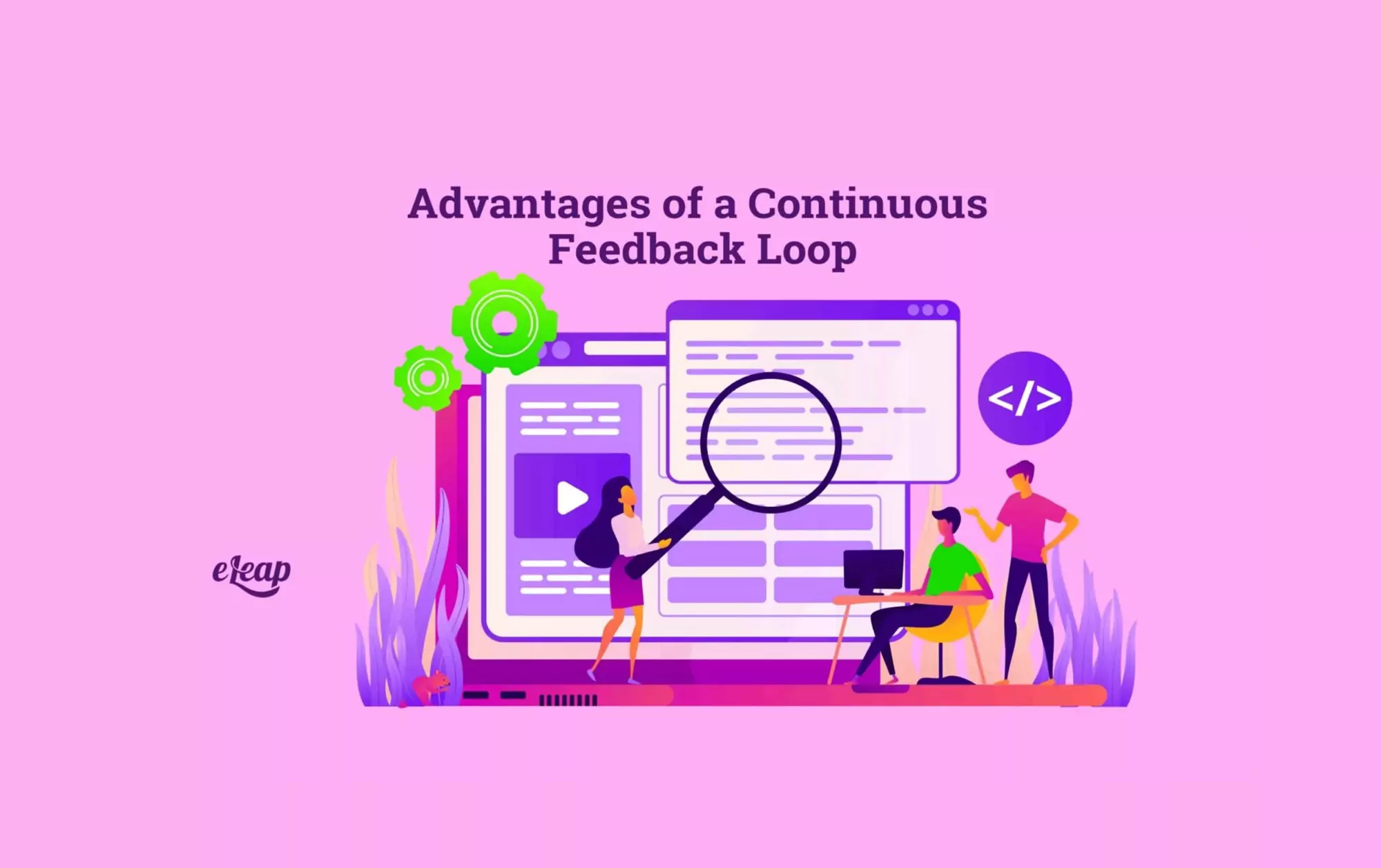Advantages of a Continuous Feedback Loop

Open communication and working within a continuous feedback loop are increasingly becoming a measure of success above all others in the business. It is common knowledge that the well-being of a company’s workforce is one of the most important and fruitful investments it can make. But anchoring that well-being to communication is something that we’re only beginning to understand. Explore how eLeaP®’s Performance Management Platform can simplify evaluations, boost productivity, and drive measurable results.
There will be moments when you will feel the urge to lavish your rockstar team with a variety of one-of-a-kind staff appreciation incentives. This might include free food, beautiful office space, corporate excursions, gym memberships, competitive bonus programs, and more.
However, the research demonstrates that the most effective method to motivate your top staff is not to provide them with expensive bonuses but to have excellent team communication. Therefore, what needs to be asked is, what are you doing to ensure an effective continuous feedback loop?

Benefits are Great, But They’re Not Everything
It’s a fact: bonuses are wonderful benefits. These ways of staff recognition are not only enjoyable but also stimulating. However, it is important to remember that benefits on their own are insufficient to generate a motivated staff. And perhaps most significantly, they are neither a suitable replacement for face-to-face connection in the workplace nor do they foster healthy communication skills.
Even the most creative incentives aren’t going to be able to give your top performers what they value most. This is especially true if their professional ambitions are the opportunity to leave their stamp on the company and advance the department’s goals.
Studies reveal that the traditional view of the gold standard of an engaged employee, who is unquestionably willing to give 100% on the job, is changing.
According to an article published on the Harvard Business Review Blog, the current most important aspect is a work environment that fully energizes individuals. This is done by encouraging their physical, emotional, and social well-being.
Continuous Feedback Loops Provide a Strong Framework
Even though many people are unaware of it, a continuous feedback loop is vital in both motivating and inspiring employees to constantly offer their best by opening up previously blocked arteries of communication.
It has been discovered that consistent communication is the cornerstone of employee engagement because it generates a stimulating and healthy work culture that is the foundation of employee engagement.
Feedback loops are not merely company benefits that emphasize recognizing and appreciating employees. They are an indispensable tool for retaining personnel and developing high-potential individuals. Not to mention their ability to spot weaknesses in our core and provide paths to improvement.
Examine Your Current Performance Review Processes
A performance review is typically conducted once or twice a year, either annually or semi-annually. Managers use this opportunity to provide employees with some type of formal criticism.
While sounding wonderful in theory, this ad hoc technique for enhancing employee performance can give the impression that the efforts being made are merely symbolic and provide few actual outcomes or overall organizational communication.
For most employees, including supervisors, annual performance evaluations are typically perceived as time-consuming, pointless, and awkward meetings between team members and supervisors.
These processes suffocate top employees, who are the very people who aspire to make a concrete difference and contribute to everyday work goals. High performers are aware that there is always room for enhancing the effectiveness of their jobs, and they flourish when allowed to give and receive constructive feedback.
Suppose managers do not communicate with employees regularly. In that case, employees will look for “greener pastures” elsewhere, believing they will be listened to and valued more than they are now working.
In Order to Grow, You Must Encourage a Continuous Feedback Loop
The improvement of communication in the workplace can take place through the use of a continuous feedback loop, which requires full participation from both parties involved.
The practice of active listening is absolutely necessary to operate this dynamic. An efficient feedback loop for employees is composed of equal parts action and reaction. It consists of the following four fundamental components:
Acquisition of information.
Inspire your staff members to speak up and share what’s on their minds. Give some structure to collecting input, but be sure to leave enough area for open-ended conversation so your business can learn its blind spots.
It is not enough for a continuous feedback loop to simply make engaging in blatant self-promotion easier. Since maintaining a competitive edge is essential to the survival of your business, you must be ready to pose challenging questions that cut to the core of issues that arise in the workplace.
Analysis of vital information.
If you want to be a good researcher, you have to be able to look at the information that you are collecting with a neutral perspective. Conduct a thorough analysis of the information you obtain from performance feedback to identify patterns you would not have noticed otherwise.
Don’t sit back – take action.
The existence of tasks that need to be done will be brought to light by an efficient continuous feedback loop. Learn to identify circumstances that require you to handle them head-on and take action as soon as you do so. Make a plan, commit to making a change, and make sure you follow through with the plan. Don’t simply speak about what you’re going to do; actually do it.
Notification of Intention
Make it clear to your staff that you are addressing their concerns by working to improve communication inside the team. What is the point of change if nobody is prepared for it and nobody is aware that it is happening? It is important to demonstrate to your staff that you take their input seriously. Communicating action to them will help increase their buy-in to the feedback system.
The value of continuous feedback loops cannot be overstated. Employees will feel heard when they know they will have regular opportunities to participate in feedback surveys. This will put them at ease knowing that their issues in the workplace will be addressed and resolved because they will know that their problems will be taken seriously.
This dynamic creates a culture of transparency and honesty in the workplace and a culture of mutual trust. These kinds of ideal work conditions are quite uncommon, yet, when top performers find themselves in contexts that recognize the need for feedback, they tend to remain in those settings for an extended period.
Benefits of a Continuous Feedback Loop
Continuous feedback loops for employees give your firm, its people, and its team the ability to be agile. You will be in a better position to keep your company functioning smoothly and effectively because you will be able to position your organization to spot problems before they occur or when they are just starting to happen.
Your staff will experience feelings of support and empowerment when the organization that they work for is in a position to respond rapidly with an efficient approach for effectively solving problems.
Let’s face it: your company’s high-potential employees are a target for recruitment efforts on the part of your competitors. Rock stars are in high demand at all times, even in times when unemployment rates are quite high.
You run a greater risk of losing your key players if you allow a greater number of problems to accumulate due to a lack of communication. You need to convince them to remain with you by providing a compelling reason. You also need to make a daily commitment to gaining their favor.
Equity That Exceeds Cash Flow
It is not unusual for businesses to provide their workers with ownership opportunities in the company. When employees feel ownership over their firm, the expectation is that they will work harder to provide value to the business.
Continuous feedback loops add an additional dimension to that level of ownership. They encourage greater workforce engagement by compelling top performers to invest emotionally in the business’s success. This is accomplished by connecting the actions of your top performers with your company’s most important goals.
They contribute to establishing a cooperative culture and an upbeat attitude in the workplace, both independent of the management structure. Continuous feedback loops that are effective enable employees to realize how their activities are directly affecting the performance of the firm. This promotes emotions of pride and belonging among employees, which increases their emotional affinity to your corporation’s bottom line.
Summary
Investing time and effort into creating an environment that encourages a sense of staff recognition and accomplishment will aid your employee retention efforts. Encouraging a continuous feedback loop might be just the start you need in the right direction.
Take the time to talk with your management team about current communication efforts and the implementation of continuous feedback loops. If you’ve made the transition to one-on-one meetings, this idea will flow well as it simply increases communication. Remind your teams that the increase isn’t what’s necessarily important but that the substance is key. Investing in the team will provide quality insight toward company growth.